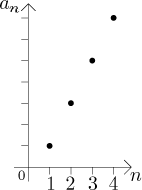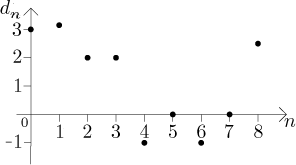Here we will introduce the notion of a sequence. We start by intuitive approach and explicit definition, then we will show recursive definition and define subsequence
What is a sequence? There are two answers, a precise one and a reasonable one. We start with the former, a formal definition, but if you do not care, just skip to the example below.
Definition.
By a sequence we mean any mapping from the set of natural numbers to the set of real numbers.
Note that we should actually say "real sequences" or "sequences of real numbers", since there are also other sequences; however, these are not covered in the basic calculus course so people usually just say "sequence".
Since such a mapping only accepts positive integers as its argument, it is
customary to denote such a sequence in a different way than as a mapping. We
can list the values of T as n goes 1,2,3,..., that is, we can
write ![]() or
or
Example: The formulas ![]() ,
,
These three definitions in our example have one thing in common: they provide
a formula that allows direct calculation of an arbitrary term of the
sequence. For instance, the tenth term of this sequence is
The other expression for the sequence, the list, is a bit tricky, because it does not specify how the other terms go. Sure, we may guess that the next term after 11 should be 13, but we cannot be sure. So this notation is used only as a supplement, when we want to get some idea how the sequence goes. We can also see much of the behaviour of a sequence by drawing its graph. In our example it is

But just like the list, it is not really reliable because we never know for sure what the sequence does after it gets out of our picture. Indeed, both the list and the graph should extend to infinity to capture all terms of this sequence, which is of course impossible. Usually we list or draw just enough terms of the sequence to show the general tendency (if there is any), it is understood that the sequence keeps going (since n keeps increasing, as it runs through all positive integers) in the suggested way.
There is another way to visualise sequences. It may be less useful now but it becomes very handy later, when we start investigating functions. We describe this way in this note.
By the way, if we wanted to define the sequence from our example using the
definition, we would use the mapping
Now we are ready to give an intuitive definition:
By a sequence we understand an infinite but countable set of real numbers with a determined order in which these numbers go.
For instance, in our example the sequence is actually all positive odd numbers that are ordered by their size from the smallest. The important thing about a sequence is the values and also their positions. Although we noted above that the list (and the graph) are not reliable for investigating properties of sequences, in fact the list captures the right idea of what a sequence is. The formulas are necessary for precise calculations, but they are just an attempt to write mathematically the idea of the given sequence, and this expression is not unique.
The example
The sequence given by
One could modify the above formal definition of a sequence to allow other forms of indexing, but this would make it more complicated and most textbooks do not bother. In practice we do not use this formal definiton anyway.
The moral of this story is that the same sequence may have many different
descriptions, sometimes it is difficult to even recognize that two
descriptions give the same sequence. You should not get too hung up on a
particular description, rather focus on the meaning. The list (and the graph)
give you some idea about the sequence, and if necessary, this idea can be
confirmed using some mathematical description of the sequence. In particular,
although the indexing
Often we do not even care at which number we start the indexing process. In
such a case we would skip references to numbering, because it is understood
that for n we put integer numbers starting from a specific one. We
then often write just
Here we will show an example of a sequence where we have a good reason to
index ![]() .
.
Obviously, we cannot substitute

Note that if we wanted, we could have indexed this sequence as
In the above examples we saw the most common way of defining a sequence: by some mathematical formula involving n. This is called the explicit definition. There are other ways. First we will show the "definition" by a list.
Example:
We started indexing at 0, so if we use d to denote terms of this
sequence, we have

An alternative graph of this sequence can be found in this note
Such definition is rarely seen; the reason is that it actually is not a definition at all. Indeed, we failed to define the whole sequence. For instance, we know that d8 = 2.5, but we do not know what is d9. In order to make it into a proper definition, one would have to somehow specify the other terms of this sequence (and there is infinitely many of them, so just a list would not do).
As we already said, list is used as a tool to have an intuitive look at the
contents of sequences. Informally it is sometimes used to refer to simple
popular sequences, probably the most popular being
In the next section we will look at another way to describe sequences, this time a proper one.
Recursive definition works as follows: We give a formula describing how to obtain the next term of the defined sequence assuming that we know the previous ones (this is called a recurrence equation). Of course, one also has to specify necessary first few terms so that the procedure can start.
Example: Our first example of a sequence
(1)
(2)
Indeed, the first term agrees,
Using
the recursive equation with
Continuing in this manner, one can check that the first several terms of the two descriptions agree, so one would hope that all are equal. This can be proved by mathematical induction.
We can also try another recursive description of the same sequence:
(1)
(2)
Again, the first three terms clearly agree:
And so on.
We immediately see the main difference between explicit and recursive definition: The recursive definition does not allow us to calculate directly a desired term of a sequence. Yet every term is uniquely determined (unlike the list notation), so this is also a proper way of defining a sequence. Many sequences can be given both explicitly and recursively, but there is no standard and/or obvious way of passing from one kind of definition to another, there is even no standard way of checking that two descriptions give the same sequence.
Although we usually prefer explicit definition (it is more practical), some sequences can be better expressed recursively and some sequences cannot even be expressed in any other way; sometimes the recursive definition also gives a better insight into the nature of a sequence. Consider the following.
Example: The Fibonacci sequence is given by the equations
(1)
(2)
In words, every term (apart from the first two) is the sum of the previous
two. The sequence goes
A sequence is an ordered bunch of numbers. Given a sequence, we obtain a
subsequence by picking some terms from this sequence and taking them
in the original order. For instance, from the sequence
Here comes the formal definition:
Definition.
Let{an} be a sequence. We obtain a subsequence of this sequence by taking some numbersk1 < k2 < k3 <... from the index set of the given series and considering the sequence.
Example: Consider the sequence
Now we pick a subsequence. We choose numbers